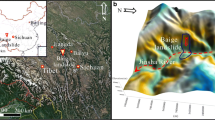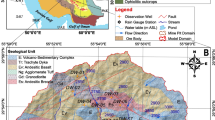Abstract
On October 10 and November 3, 2018, two successive landslides occurred at Baige village, the border between Sichuan Province and Tibet Autonomous Region, in China, which totally dammed the Jinsha River on both occasions. Due to the rapid rise in water level in the “10·10” dammed lake, on October 12, the landslide dam breached naturally with the peak breach flow of about 10,000 m3/s. The residual landslide dam was stacked by the subsequent landslide on November 3, resulting in an even larger dammed lake. Fortunately, the height from the water level in the lake to the dam crest made it possible to construct a spillway to drain the water in the dammed lake to a relatively low level. On November 12, the drainage process began with the peak breach flow of 31,000 m3/s. In this study, based on the detailed records of the breach process of the “11·03” Baige landslide dam and using the developed physically based numerical method, a back analysis was conducted. The numerical method was developed based on the overtopping-induced breach mechanism of landslide dams. An iterative time step algorithm was used to simulate the breach evolution and the hydrograph coupling. The major highlights of the numerical method are the consideration of the breach mechanism of landslide dam, such as the breach morphology evolution process along the streamwise and transverse directions, as well as the variation of soil erodibility with depth and the influence of the presence and absence of a spillway. Comparison of the measured and the calculated results indicated that the numerical method developed in this study can reproduce reasonable breach hydrograph and breach evolution process. The sensitivity analysis showed that the soil erodibility coefficient and the residual dam height significantly influenced the landslide dam breaching process. In addition, it was determined that constructing a spillway before landslide dam breaching is an effective flood hazard mitigation measure for large dammed lakes. However, the availability of the construction conditions and the shape of the spillway should be judged comprehensively according to the rising rate of water level and construction capacity.
















Similar content being viewed by others

References
Annandale GW (2006) Scour technology-mechanics and engineering practice. Mcgraw-Hill, New York, p 430
ASCE/EWRI Task Committee on Dam/Levee Breach (2011) Earthen embankment breaching. J Hydraul Eng 137(12):1549–1564
Briaud JL, Ting FCK, Chen HC, Cao Y, Han SW, Kwak KW (2001) Erosion function apparatus for scour rate prediction. J Geotech Geoenviron Eng 127(2):105–113
Cai YJ, Luan YS, Yang QG, Xu FX, Zhang SJ, Shi Y, Yidu LZ (2019) Study on structural morphology and dam-break characteristics of Baige barrier dam on Jinsha River. Yangtze River 50(3):15–22 (in Chinese)
Cao ZX, Yue ZX, Pender G (2011a) Landslide dam failure and flood hydraulics. Part I: experimental investigation. Nat Hazards 59(2):1003–1019
Cao ZX, Yue ZX, Pender G (2011b) Landslide dam failure and flood hydraulics. Part II: coupled mathematical modeling. Nat Hazards 59(2):1020–1045
Casagli N, Ermini L, Rosati G (2003) Determining grain size distribution of the material composing landslide dams in the Northern Apennines: sampling and processing methods. Eng Geol 69(1–2):83–97
Chang DS, Zhang LM (2010) Simulation of the erosion process of landslide dams due to overtopping considering variations in soil erodibility along depth. Nat Hazards Earth Syst Sci 10(4):933–946
Chang DS, Zhang LM, Xu Y, Huang RQ (2011) Field testing of erodibility of two landslide dams trigged by the 12 may Wenchuan earthquake. Landslides 8(3):321–332
Chen SC, Lin TW, Chen CY (2015a) Modeling of natural dam failure modes and downstream riverbed morphological changes with different dam materials in a flume test. Eng Geol 188:148–158
Chen ZY, Ma LQ, Yu S, Chen SJ, Zhou XB, Sun P, Li X (2015b) Back analysis of the draining process of the Tangjiashan barrier lake. J Hydraul Eng 141(4):05014011
Chen ZY, Zhang Q, Hou JM, Wang L, Ma LP (2019) Back analysis on dam-breach flood of “10·10” Baige barrier lake on Jinsha River. Yangtze River 50(5):1–4 (in Chinese)
Cheng HY (2019) Hydrology emergency monitoring and forecast on “11·3” Baige barrier lake, Jinsha River. Yangtze River 50(3):23–27 (in Chinese)
Costa JE (1985) Floods from dam failures. US Geological Survey, Open-File Report 85–560, Denver, p 12
Costa JE, Schuster RL (1988) The formation and failure of natural dams. Geol Soc Am Bull 100:1054–1068
Davies TR, Manville V, Kunz M, Donadini L (2007) Modeling landslide dambreak flood magnitudes: Case study. J Hydraul Eng 133(7):713–720
Dunning SA (2006) The grain size distribution of rock-avalanche deposits in valley confined settings. Ital J Eng Geol Environ 1:117–121
Fan XM, Xu Q, Alonso-Rodriguez A, Subramanian SS, Li WL, Zheng G, Dong XJ, Huang RQ (2019) Successive landsliding and damming of the Jinsha River in eastern Tibet, China: prime investigation, early warning, and emergency response. Landslides 16(5):1003–1020
Graf WH (1984) Hydraulics of sediment transport. Water Resources Publications, Colorado, p 513
Gregoretti C, Maltauro A, Lanzoni S (2010) Laboratory experiments on the failure of coarse homogeneous sediment natural dams on a sloping bed. J Hydraul Eng 136(11):868–879
Hanson GJ, Cook KR (2004) Determination of material rate parameters for headcut migration of compacted earthen materials. Proceedings of dam safety 2004, Association of State dam Safety Officials (ASDSO), in CD-ROM
Liang GL, Wang Z, Zhang GW, Wu LL (2019) Two huge landslides that took place in quick succession within a month at the same location of Jinsha River. Landslides 16(5):1059–1062
Liao HM, Yang XG, Xu FG, Xu H, Zhou JW (2018) A fuzzy comprehensive method for the risk assessment of a landslide-dammed lake. Environ Earth Sci 77:750
Liu N, Chen ZY, Zhang JX, Lin W, Chen WY, Xu WJ (2010) Draining the Tangjiashan barrier lake. J Hydraul Eng 136(11):914–923
Liu WM, Carling PA, Hu KH, Wang H, Zhou Z, Zhou LQ, Liu DZ, Lai ZP, Zhang XB (2019) Outburst floods in China: a review. Earth-Sci Rev 197:102895
Niu ZP, Xu WL, Li NW, Xue Y (2012) Experimental investigation of the failure of cascade landslide dams. J Hydrodyn 24(3):430–441
Ouyang CJ, An HC, Zhou S, Wang ZW, Su PC, Wang DP, Cheng DX, She JX (2019) Insights from the failure and dynamic characteristics of two sequential landslides at Baige village along the Jinsha River, China. Landslides 16(7):1397–1414
Peng M, Zhang LM (2012) Breaching parameters of landslide dams. Landslides 9(1):13–31
Shi ZM, Ma XL, Peng M, Zhang LM (2014) Statistical analysis and efficient dam burst modelling of landslide dams based on a large-scale database. Chin J Rock Mech Eng 33(9):1780–1790 (in Chinese)
Singh VP (1996) Dam breach modeling technology. Kluwer Academic, Dordrecht, pp 41–54
Wu WM (2013) Simplified physically based model of earthen embankment breaching. J Hydraul Eng 139(8):837–851
Zhang Z, He SM, Liu W, Liang H, Yan SX, Deng Y, Bai XQ, Chen Z (2019a) Source characteristics and dynamics of the October 2018 Baige landslide revealed by broadband seismograms. Landslides 16(4):777–785
Zhang LM, Xiao T, He J, Chen C (2019b) Erosion-based analysis of breaching of Baige landslide dams on the Jinsha River, China, in 2018. Landslides 16(10):1965–1979
Zhao TL, Chen SS, Fu CJ, Zhong QM (2019) Centrifugal model tests and numerical simulations for barrier dam break due to overtopping. J Mt Sci 16(3):630–640
Zhong QM, Chen SS, Mei SA, Cao W (2018) Numerical simulation of landslide dam breaching due to overtopping. Landslides 16(6):1183–1192
Zhou GGD, Zhou MJ, Shrestha MS, Song DR, Choi CE, Cui KFE, Peng M, Shi ZM, Zhu XH, Chen HY (2019) Experimental investigation on the longitudinal evolution of landslide dam breaching and outburst floods. Geomorphology 334:29–43
Data availability statement
All data used in the study are available from the corresponding author by request.
Funding
This study was financially supported by the National Key Research and Development Program of China (Grant No. 2018YFC1508604), the National Natural Science Foundation of China (Grant Nos. 51779153 and 51539006), and the Fundamental Research Funds for Central Public Research Institutes (Grant No. Y319003).
Author information
Authors and Affiliations
Corresponding author
Rights and permissions
About this article
Cite this article
Zhong, Q., Chen, S., Wang, L. et al. Back analysis of breaching process of Baige landslide dam. Landslides 17, 1681–1692 (2020). https://doi.org/10.1007/s10346-020-01398-3
Received:
Accepted:
Published:
Issue Date:
DOI: https://doi.org/10.1007/s10346-020-01398-3



